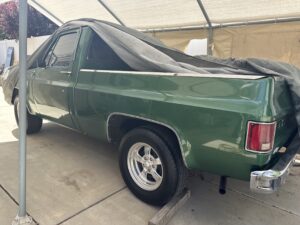
This 1976 Chevrolet C10 VIN Verification was done by our team member in Lake Elsinore, Ca. on 15-13-2025

This 1976 Chevrolet C10 VIN Verification was done by our team member in Lake Elsinore, Ca. on 15-13-2025
The 1976 Chevrolet C10 is part of Chevy’s beloved “Square Body” truck generation, known for its clean lines, boxy shape, and rugged utility. Positioned as a light-duty half-ton pickup in the C/K Series, the C10 was aimed at everyday drivers, tradesmen, and enthusiasts alike. By 1976, the C10 had cemented itself as one of America’s most iconic and customizable trucks, offering a balance between capability, comfort, and classic truck styling.
Chevrolet introduced the third generation of its C/K Series trucks—commonly referred to as the “Square Body” generation—in 1973. The C10, the 2WD half-ton model, became the best-selling configuration of the lineup. These trucks were a departure from the rounded fender look of earlier models and were instead built with angular, slab-sided sheet metal that gave them their iconic silhouette. The 1976 model marked the mid-point in this generation, showcasing a maturing lineup with growing comfort and option packages.
The 1976 Chevrolet C10 offered a wide range of engines suited for everything from basic hauling to light-duty performance:
4.1L (250 cu in) Inline-6
~105 horsepower
Basic, economical engine for utility work
4.8L (292 cu in) Inline-6
~120 horsepower
Larger six-cylinder for more torque
5.0L (305 cu in) V8
~145 horsepower
5.7L (350 cu in) V8
~165–175 horsepower
Most popular and well-balanced engine choice
6.6L (400 cu in) V8
~175–185 horsepower
High-torque option for heavier use
Transmission options included:
3-speed manual (column-shifted)
4-speed manual
3-speed Turbo-Hydramatic automatic transmission
The 1976 C10 retained the trademark “Square Body” design, with sharp lines, a wide grille, and a sculpted hood. Key design and comfort features included:
Front egg-crate grille design, updated from previous years
Sloped windshield and flush-fitting glass for aerodynamics
Dual rectangular headlights and optional chrome trim
Fleetside and Stepside bed options, 6.5 or 8 feet long
Interior features like bench seats, optional AM/FM stereo, and air conditioning
Trim upgrades introduced cloth upholstery, woodgrain dash appliqués, and power accessories in upper trims.
The C10 was offered in several trim levels in 1976:
Base Custom – Vinyl interior, basic features
Custom Deluxe – Added interior refinement, more chrome
Scottsdale – Mid-level trim with comfort upgrades
Cheyenne – Premium trim with woodgrain interior accents, more insulation
Cheyenne Super (rare) – Top-of-the-line with upgraded upholstery, trim, and convenience features
Bed styles:
Stepside – Traditional exposed fenders
Fleetside – Smooth-sided, modern appearance
While safety technology was limited by modern standards, the 1976 C10 did offer several noteworthy features:
Energy-absorbing steering column
Larger brakes for improved stopping power
Safety glass, lap belts, and padded dashboard
Optional dual fuel tanks with a cabin selector switch
Optional rear sway bar for improved handling and control
Fuel economy was not a strong suit for 1970s pickups:
Inline-6 engines: ~13–15 MPG
Small-block V8s (305/350): ~10–13 MPG
400 V8: ~9–11 MPG under load
Fuel economy varied greatly based on configuration, load, and driving style. Most C10s had 20-gallon fuel tanks, with an optional dual-tank setup for longer range.
In 1976, the C10 competed with:
Ford F-100 – The closest rival, with similar capability and features
Dodge D100 – A less popular but capable option
International Harvester Pickup – Rugged, less refined
GMC C15 – Essentially a badge-engineered version of the C10
The C10 gained a loyal following due to its ease of maintenance, availability of parts, and reliable powertrain options.
Original MSRP (1976): ~$3,500–$5,500 depending on trim and engine
Today’s Market (2025):
Fair condition/project trucks: ~$6,000–$12,000
Good condition/drivable: ~$15,000–$25,000
Restored or custom builds: $30,000–$55,000+
Prices vary based on originality, engine, restoration quality, and location.
Part of the best-selling Chevy truck line of the 1970s
Often listed in “Top 10 Classic Trucks of All Time” by enthusiast sites
Celebrated in classic truck shows for its timeless design and build quality
Strong aftermarket and enthusiast community today, with support for restoration and performance builds
Need a VIN Verification? We are licensed to complete the REG 31 form. Call to get your car, truck or motorcycle verified today!
© 2025 QUICK VIN VERIFICATION. All rights reserved.